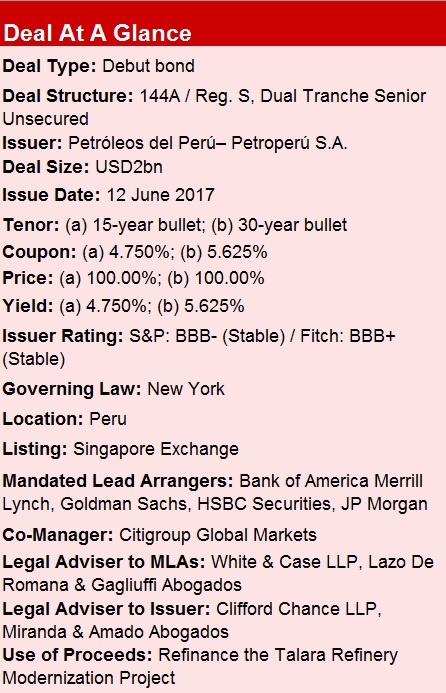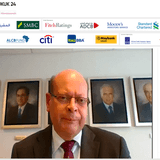 Background
Background
As part of its modernization and expansion strategy, Petroperu, which is 100% owned by the Republic of Peru and is the country’s largest corporate by revenue, needed to refinance the Talara Refinery Modernization Project, its largest refinery to date.
The PMRT, with a total cost of approximately USD5bn, has a completion deadline set for 2020. It is expected to have a radical impact on the company’s EBITDA generation when finished, raising it from around USD350mn in 2016 to approximately USD780mn in 2021 through a higher-margin product mix, higher volumes and a heavier / lower-cost oil feedstock. It will also allow Petroperu to produce fuels with less than 50ppm, in line with prevailing Peruvian environmental regulations.
On 12 June, Petroperú launched its DCM debut – a long-tenor dual-tranche USD2bn 144a/RegS bond, which anchored the long-term debt structure of the PMRT and allowed the company to extend tenors on a number of short-term and medium-term financing obligations.
Transaction Breakdown
In June 2017 the state-owned Petroperú, the largest corporate in Peru in terms of revenue, conducted an extensive roadshow, covering almost 100 accounts in one-to-one meetings, conference calls, and group events in New York, London, Los Angeles, Boston, Lima, and Santiago.
The marketing effort presented a clear challenge in that it often involved the introduction of a new credit and sector, one standing in the midst of a sizable investment process and facing fairly significant potential risks in terms of construction, leverage, and overall execution.
Despite those concerns, a robust market environment – buoyed by a better-than-expected recovery from the El Nino – and sound investor feedback led to the announcement of a dual-tranche transaction with IPTs of 5% area for a 15-year tranche and 6% area for a 30-year tranche.
A shadow book accumulating orders of more than USD1.5bn built up in the run-up to the announcement, which then grew throughout the morning of 12 June NY time, and by the early afternoon guidance was announced at 4.875% (+/- 0.125%) and 5.750% (+/- 0.125%) for the 15- and 30-year tranches, respectively. Solid momentum allowed the issuer to launch USD1bn for each tranche at the tight end of guidance: 4.750% for the 15-year tranche and 5.625% for the 30-year tranche.
Peru’s tight yields at time of issuance (2027s at 2.96%, 2050s at 4.25%), the relatively limited amount of Peruvian dollar-denominated new supply in months prior to the trade, and a very positive overall tone in riskier markets all contributed to pricing Peru’s tightest yielding credit at the time of issuance. The deal priced at a premium of roughly 140bp over the sovereign’s USD bonds and well inside secondary market yields of comparable quasi-sovereign Latin American peers like Pemex, Ecopetrol, YPF and Petrobras.
North America received the bulk of the allocations (46% for 15-year and 65% for 30-year), with another 38% and 33% of the notes, respectively, going to EMEA-based accounts. Of the 15-year, 10% stayed in Latin America, as did 1% of the 30-year tranche.
By type, asset/fund managers snapped up 63% of the 15-year and 81% of the 30-year; 26% and 6%, respectively, were placed with pension and insurance funds, 10% each with banks, and rest went to other types of investors.
In addition to being Petroperú’s debut offering, the deal also marked the largest corporate issuance from a Peruvian issuer, the first 30-year corporate issuance from Peru and the largest corporate debut issuance from a Latam issuer. Petroperú also joined a very exclusive club of Latin American credits to have debuted in the bond markets with a bold 30-year issue.









